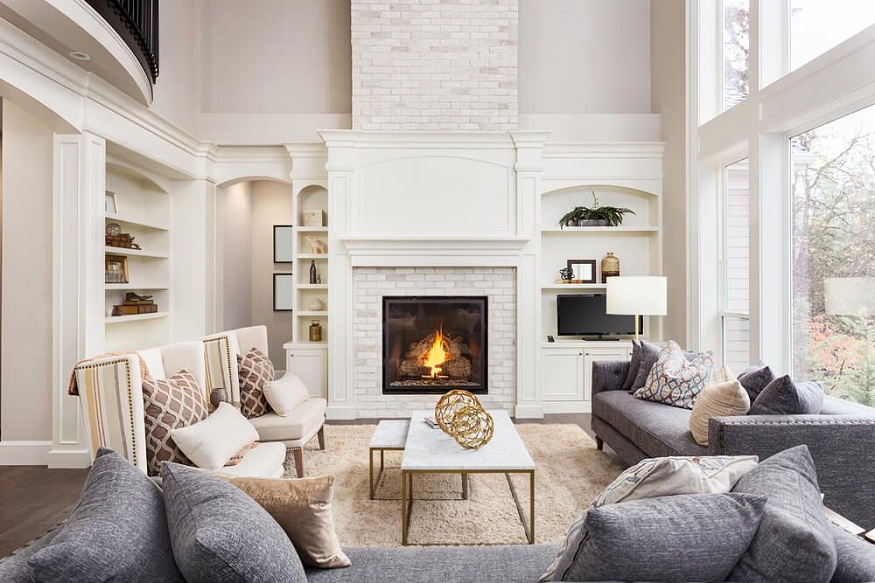In today’s competitive property market, making a strong first impression can mean the difference between a swift sale and months of stagnation.This is where the power of interior staging shines. It’s not just about furniture and cushions—it’s about creating an atmosphere that allows prospective buyers to instantly picture themselves living there.
Successful staging interior design has emerged as a valuable strategy for property owners and estate agents alike. It blends style with psychology, using thoughtful layouts, purposeful decor, and subtle cues to spark desire in potential buyers. With the UK average property selling time stretching to around 65 days in 2025 (source: Rightmove), staging can be the difference between a home sitting on the market or selling in just a few weeks.
Why First Impressions Matter More Than Ever
When it comes to property viewings, most buyers form their first impressions within the first 10 seconds of entering a home. Whether it’s the welcoming scent of fresh flowers in the hallway or a sunlit lounge that feels effortlessly cosy, these early moments set the tone for the entire viewing.
With growing competition, especially in key urban areas like London, Bristol, and Manchester, buyers have more options than ever. According to Zoopla’s 2025 Housing Market Report, 78% of buyers say a home’s presentation plays a major role in their decision-making. That means creating an inviting environment isn’t optional—it’s essential.
The Psychology Behind Staging Success
The magic of staging lies in tapping into a buyer’s emotions. A well-dressed room can help someone visualise a lifestyle, not just a layout. Think of a minimalist dining room transformed into an elegant entertaining space with soft lighting, tasteful art, and a table set for six. These touches speak to aspirations—relaxation, family dinners, or hosting friends.
This psychological trigger is backed by behavioural science. Studies show that staged homes can help reduce the mental effort buyers need to make decisions. By removing personal clutter and injecting neutral, tasteful design elements, staging helps create a ‘blank canvas’ that allows the imagination to take over. Rather than wondering what the space could be, buyers feel like they’re already home.
Small Touches, Big Impact
You don’t need to spend a fortune to create impact through staging. In fact, subtle changes often deliver the greatest return. Swapping heavy curtains for light, flowing ones can immediately make a room feel bigger and brighter. Replacing outdated lighting with modern pendant fixtures adds instant sophistication. And mirrors? They’re not just decorative—they bounce light and expand perceived space.
Kitchen and bathroom staging is especially crucial. These are high-value areas where attention to detail counts. A sparkling worktop, fresh towels, or a bowl of lemons can make a surprising difference. Research from the HomeOwners Alliance shows that staged kitchens can add up to 8% to the perceived value of a property.
Styling with Purpose, Not Just Pretty Things
Every design decision in a staged home should be intentional. While aesthetics matter, functionality is just as important. For example, a tiny box room that’s awkwardly empty might be reimagined as a home office—adding value for remote workers. An underutilised alcove could be turned into a reading nook or display space, subtly demonstrating how to maximise every square metre.
Colour choices play a vital role too. Neutral palettes tend to have the broadest appeal, but that doesn’t mean bland. Layering shades of cream, grey, and taupe with natural textures—think jute rugs, linen throws, or rattan accents—adds depth without overpowering the senses. Plants, too, are an easy win. A few well-placed indoor plants bring life and freshness, improving air quality and adding visual balance.
The Role of Furniture in Creating Flow
Furniture staging is about more than just filling empty rooms. It’s about defining spaces and guiding the viewer through the home with ease. Oversized sofas or awkward layouts can interrupt flow, making a space feel disjointed. Instead, pieces should be scaled appropriately, with clear walkways and inviting conversation areas.
Multi-functional furniture is particularly useful in smaller homes or flats. A sleek dining table that doubles as a desk, or an ottoman with hidden storage, can subtly demonstrate the home’s adaptability. The goal is to highlight space potential, not overwhelm it. Well-staged furniture lets the property speak for itself—and that’s where interior design truly excels.
Adapting to the Local Market
Staging should always reflect the preferences of the local buyer demographic. A two-bedroom flat in Shoreditch may benefit from industrial touches and contemporary art, while a family home in Surrey might lean towards traditional styling and cosy features. Knowing your audience is crucial—and so is understanding how they live.
According to a 2024 survey by Propertymark, 62% of UK buyers preferred staged homes that felt ‘move-in ready’. This demand for turnkey properties means sellers who invest in staging can command stronger offers and potentially reduce the need for price negotiation. It’s not about staging for vanity—it’s a strategic move tailored to specific buyers in specific markets.
Staging That Supports Digital First Impressions
In today’s online-first world, most buyers fall in love with a property long before they step through the door. High-quality photographs, 3D tours, and video walkthroughs mean staging must also shine on screen. Harsh lighting, messy wires, or dull rooms can ruin what might otherwise be a perfect space.
Professional staging enhances not only physical viewings but digital ones too. Properties that are styled and shot professionally receive 40% more clicks on portals like Rightmove and Zoopla, and often generate more in-person viewings. If your property doesn’t look picture-perfect online, you may be losing potential buyers before the phone even rings.
Is Staging Worth the Investment?
Absolutely. According to the Home Staging Association UK & Ireland, staged homes in the UK sell twice as fast as non-staged ones and can secure offers up to 10% above asking price. With the average UK house price at around £286,000 in 2025 (ONS), even a modest increase in sale value offers a solid return on a staging investment of just a few thousand pounds.
For sellers working with experienced estate agents, a professional staging service can become a key marketing tool. It demonstrates to buyers that the home has been cared for, thoughtfully presented, and is ready for its next chapter. More than décor, staging is a selling strategy rooted in buyer psychology and visual storytelling.
Final Thoughts: Creating Love at First Sight
In the end, successful staging isn’t about pretending or disguising flaws—it’s about helping buyers see the potential. It’s a subtle, sophisticated process that creates emotional resonance, practical flow, and aesthetic balance. When done right, it transforms a viewing into a powerful experience—one that lingers long after the door closes.
If you’re preparing to sell and want to create that lasting impact, don’t underestimate the art and strategy behind home presentation. With expert guidance and a keen eye for design can turn your property from just another listing into someone’s dream home.

